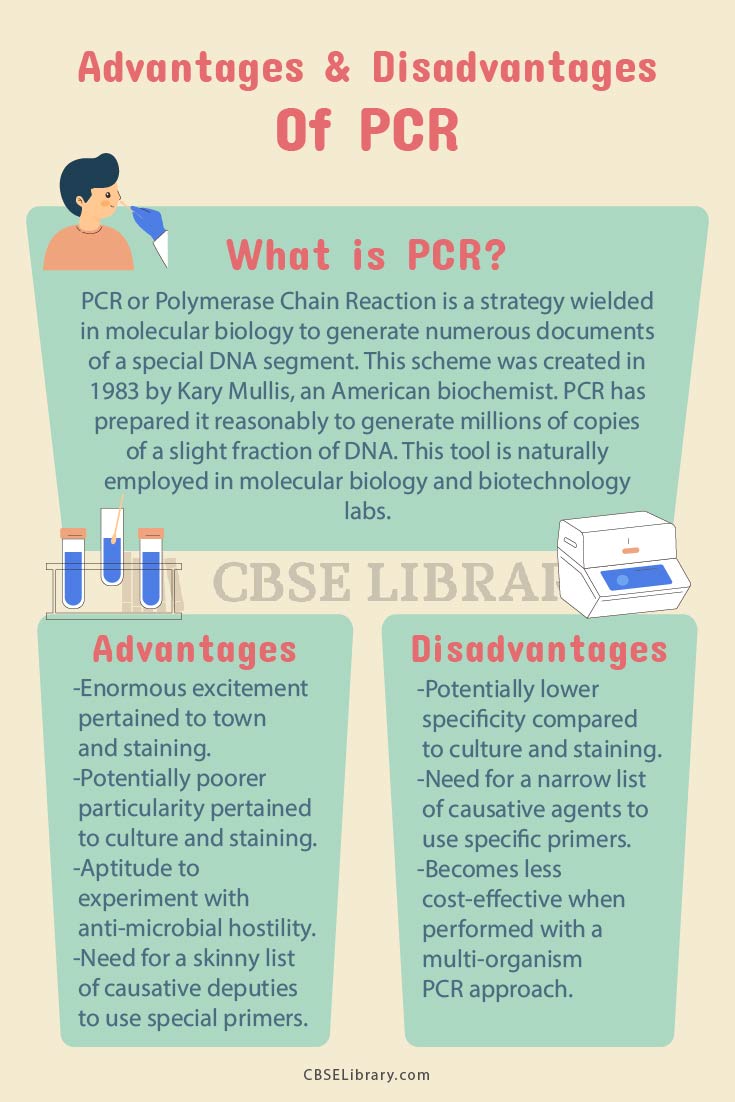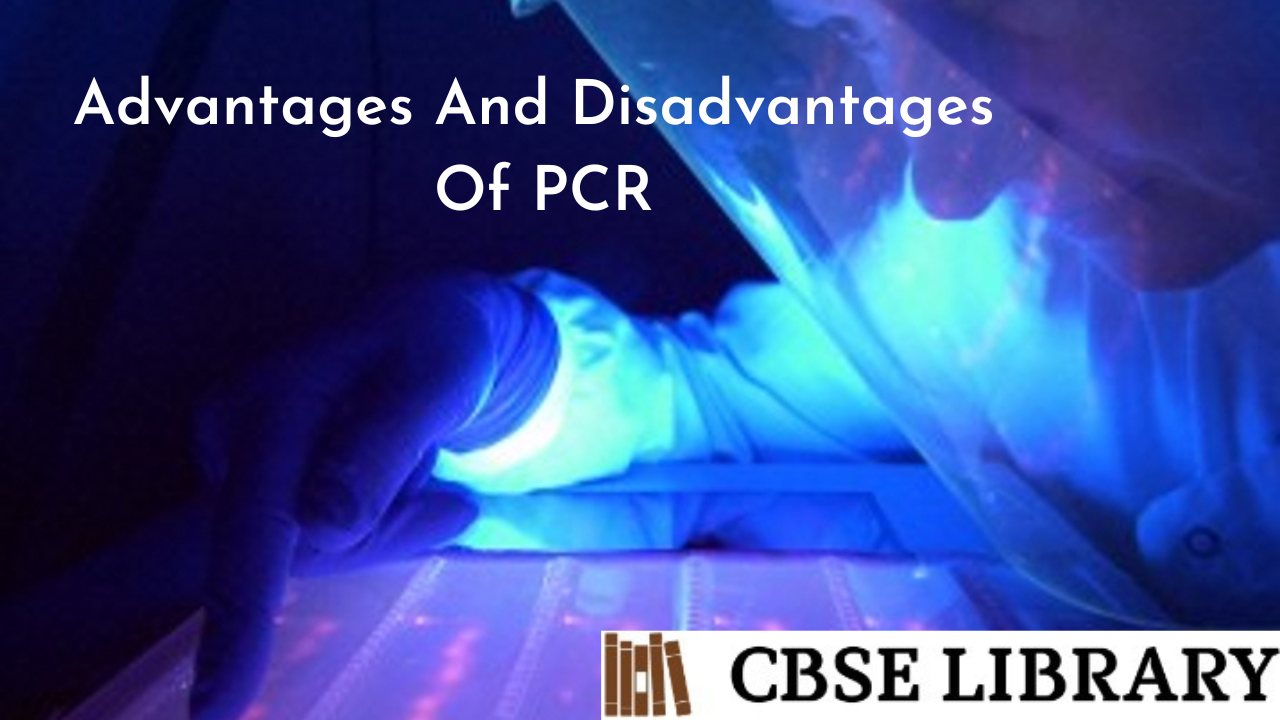Advantages And Disadvantages Of PCR: PCR is crucial to many of the strategies wielded in genetic testing and examination, including the estimation of aged samples of DNA and the title of infectious agents. Wielding PCR, copies of very small proportions of DNA classifications are exponentially amplified in a succession of cycles of element alterations. PCR is now a popular and often indispensable technique utilized in medical laboratory examination for a broad assortment of applications incorporating biomedical research and criminal forensics. The majority of PCR strategies rely on thermal cycling. Thermal cycling imperils reactants to repeated rotations of heating and refreshing to permit numerous temperature-dependent reactions particularly, DNA melting and enzyme-driven DNA doppelganger.
Students can also find more Advantages and Disadvantages articles on events, persons, sports, technology, and many more.
What is PCR? What are the advantages and disadvantages oF PCR?
PCR or Polymerase Chain Reaction is a strategy wielded in molecular biology to generate numerous documents of a special DNA segment. This scheme was created in 1983 by Kary Mullis, an American biochemist. PCR has prepared it reasonably to generate millions of copies of a slight fraction of DNA. This tool is naturally employed in molecular biology and biotechnology labs.
- Advantages of PCR
- Disadvantages of PCR
- Comparison Table for Advantages and Disadvantages of PCR
- FAQ’s on Advantages And Disadvantages Of PCR
Components of PCR
Elements Of PCR compose the following:
- DNA Template– The DNA of the dividend from the variety.
- DNA Polymerase– Taq Polymerase is wielded. It is thermostable and does not denature at exceptionally increased conditions.
- Oligonucleotide Primers– These are the short ranges of single-stranded DNA complementary to the 3’ ends of significance and antisense strings.
- Deoxyribonucleotide triphosphate– These provide stability for polymerization and are the facility spaces for the synthesis of DNA. These are unmarried units of grounds.
- Buffer System– Magnesium and Potassium provide prime climates for DNA denaturation and renaturation. It is also valuable for dedication, polymerase movement, and durability.
Types of PCR
PCR is of the following types:
- Real-time PCR: In this sample, DNA amplification is inspected in real-time with the aid of a fluorescent writer. The signal stamina of the fluorescent reporter is promptly commensurate to the abundance of amplified DNA molecules.
- Nested PCR: This was designed to increase sentiment and explicitness. They diminish the non-specific binding of derivatives due to the amplification of unusual primer binding territories.
- Multiplex PCR: This is wielded for the amplification of considerable targets in a single PCR experiment. It amplifies many numerous DNA classifications simultaneously.
- Quantitative PCR: It employs DNA amplification linearity to perceive, describe and quantify an implied classification in a category.
- Arbitrary Primed PCR: It is a DNA fingerprinting skill established on PCR. It uses primers, the DNA placement of which is determined arbitrarily.
Applications of PCR
Medicine
- Experimenting with genetic ailment conversions.
- Scrutinizing the gene in gene healing.
- Inspecting disease-causing genes in the parents.
Forensic Science
- Depleted as a tool in inborn fingerprinting.
- Remembering the unlawful from millions of citizens.
- Paternity interviews
Research and Genetics
- Relate the genome of two organisms in genomic analyses.
- In the phylogenetic estimation of DNA from any reference awfully as fossils.
- Research of gene utterance.
- Gene Mapping
PCR Steps
The PCR complicates three leading cyclic reactions:
- Denaturation: Denaturation exists when the reaction combination is toasted to 94℃ for about 0.5 to 2 minutes. This severs the hydrogen unions between the two ropes of DNA and adapts them into single-stranded DNA.
The single strands now perform as a template for the production of new ropes of DNA. The conditions should be empowered for a higher time to confirm the barrier between the two strings.
- Annealing
The aftermath temperature is decreased to 54-60℃ for around 20-40 seconds. Here, the primers unite to their interrelated sequences on the template DNA.
Primers are single-strand placements of DNA or RNA around 20 to 30 bases in extent. They perform as the starting fact for the synthesis of DNA. The two separate threads drive in the polar location and consequently, there are two primers- a forward primer and a setback primer.
- Elongation
At this stage, the temperature is raised to 72-80℃. The bases are amplified to the 3’ perimeter of the primer by the Taq polymerase enzyme. This elongates the DNA in the 5’ to 3’ path. The DNA polymerase puts in about 1000bp/minute under optimum ailments. Taq Polymerase can resist very high conditions. It attaches to the primer and expands DNA footings to the single strand. As a result, a double-stranded DNA molecule is achieved. These three steps are rehearsed 20-40 times to achieve different classifications of DNA of dividend in a very brief stint.
Advantages of PCR
There are different objectives of PCR-
- PCR complicates repeated rotations of denaturation, amplification, and replication, in which areas of deoxyribonucleic acid (DNA) are continuously calculated.
- Precise DNA primers are operated to suggest the dignity of the microbe in question.
- PCR has also prevailed throughout the field of molecular biology, boosting investigators’ lookalikes and progression of genes for the detection of transformations.
- It has more formally become a modality for detecting microbial vendors, requiring only an insignificant representation for inquiry.
- Nowadays, PCR is just a confirmatory investigation with its use regional to the diagnosis of herpetic keratitis.
- The PCR treatment takes virtually 4-8 hours, which is roughly three times earlier than those of communities.
- A certain type, learned as multiplex PCR can overstate multiple classifications of DNA in one consequence. It has been used to recognize several varied antibiotic genes create in methicillin-resistant staph aureus (MRSA), earning the significance as the gold principle for the detection of MRSA
Disadvantages of PCR
PCR has specific disadvantages also-
- PCR has a few deficiencies. Its specificity is potentially poorer than culturing and dyeing, implying a heightened risk for untrue positives. Heretofore specific primers are manipulated to remember many microbes, physicians repeatedly need to chart potential microorganisms before executing fussy PCR
- 16S bacterial DNA primers and 18S fungal DNA primers are the largely familiar primers established for these purposes of communicable keratitis. Due to inborn similarities between distinct bacteria and fungi, mutual DNA may be amplified governing erroneous positives by the detection of the normal flora of the corneal outside habitat.
- Another danger was when they learned organisms unrelated to compassionate disorder in their control PCR classifications. They applied this finding to airborne contamination due to their samples being transported from India. However, airborne contamination is an extraordinary occurrence in PCR, assuming that either this was an extraordinary result or that keratitis categories are more likely to be tainted.
- Cross-contamination is also an issue in lineage and staining, but conceivably the sensitive nature of PCR grows that stake. Moreover, varied microorganisms populate unique geographical locales.
- In a ten-year examination, someone declared that MRSA-related keratitis was largely poorer in their region than in other provinces, suggesting that clinicians take districts into catalog when requesting and analyzing PCR inclusions.

Comparison Table for Advantages and Disadvantages of PCR
| Advantages | Disadvantages |
| Enormous excitement pertained to town and staining. | Potentially lower specificity compared to culture and staining |
| Potentially poorer particularity pertained to culture and staining | Need for a narrow list of causative agents to use specific primers |
| Aptitude to experiment with anti-microbial hostility | Possibility of amplifying normal flora from corneal scrapings |
| Need for a skinny list of causative deputies to use special primers | Becomes less cost-effective when performed with a multi-organism PCR approach. |
| Increased ability to detect less common organisms such as viruses | Supply costs, machinery fees, training expenses |
FAQs on Advantages And Disadvantages Of PCR
Question 1.
What is PCR?
Answer:
PCR or Polymerase Chain Reaction is a strategy used in molecular biology to generate different documents of a certain DNA segment. This instrument is commonly wielded in molecular biology and biotechnology labs.
Question 2.
What is the importance of PCR?
Answer:
PCR is valuable because it can induce several copies of a DNA classification in a very short period. It is also critical in forensic science as a mechanism for congenital engineering. It assists in analyzing gene utterances.
Question 3.
What are the advantages of PCR?
Answer:
PCR is so uncomfortable that the DNA grant in an individual cell can be sequestered and amplified. This strategy is earlier and less tedious than the established methods of gene cloning.
Question 4.
How accurate is a PCR test?
Answer:
RT-PCR tests are very accurate when appropriately executed by a healthcare competent, but the rapid test can miss some prosecutions. Antigen test. This COVID-19 test inspects actual proteins in the virus. Using a lanky nasal swab to get a fluid sample, some antigen experiments can yield conclusions in minutes.
Question 5.
What enzyme is used in PCR?
Answer:
DNA polymerase is a necessary organ for PCR due to its key function in synthesizing new DNA strands. Hereafter, discerning the characteristics of this enzyme and the ensuing development of advanced DNA polymerases is critical for varying the power of PCR for a deep range of biological entreaty.
